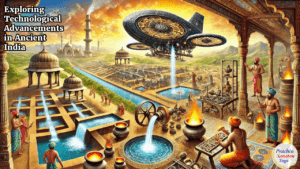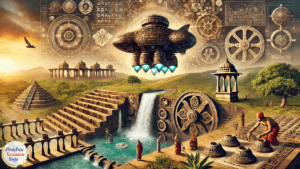
Technological advancements in ancient India
Technological advancements in ancient India
Human civilizations have always strived to understand the natural world and harness its resources for progress. Despite lacking modern tools, ancient societies achieved remarkable technological advancements that often leave us in awe. We are often amazed by the advanced metallurgy of India, the architectural wonders of the Mayans, and the ingenious water management systems of Mesopotamia. The ancient world was a hub of innovation, with technological achievements that continue to fascinate us today.
This article explores some of the fascinating technological achievements of ancient India and other civilizations, focusing on areas such as aviation, metallurgy, and water management systems.
“Vimana: Ancient India’s Mystical Aviation Technology“
One of the most intriguing aspects of ancient Indian literature is its mention of Vimanas—aerial vehicles described in texts like the Vedas and the Ramayana. The concept of Vimanas has captivated historians, scientists, and researchers for decades due to their uncanny resemblance to modern aviation.
Descriptions in Ancient Texts:-
Vimanas are detailed in Sanskrit texts like the Vaimanika Shastra, attributed to sage Maharshi Bharadwaja. These flying machines were said to have advanced capabilities, including the ability to travel vast distances and hover mid-air. They were reportedly powered by mysterious energy sources, potentially hinting at lost knowledge of propulsion.
Scientific Interpretations:-
While many scholars view Vimanas as allegorical or mythological, some believe they reflect a deeper understanding of aerodynamics and flight mechanics. Whether real or symbolic, these descriptions underline the innovative thinking and imagination of ancient Indian scholars.
Cultural Legacy:-
The concept of Vimanas has inspired modern researchers to revisit ancient texts, sparking debates about whether ancient India possessed advanced technological knowledge now lost to history.
Table of Contents

“Water Management: Engineering Marvels of Ancient Civilizations”
The survival and prosperity of ancient civilizations relied on the critical management of water. Ingenious systems were developed for the efficient harnessing, storing, and distribution of water.
The Harappan Civilization:-
The Indus Valley Civilization (2600–1900 BCE) in ancient India demonstrated unparalleled expertise in urban planning and water management. Cities like Mohenjo-Daro and Harappa had sophisticated drainage systems, wells, and reservoirs. These systems ensured the efficient removal of wastewater and the availability of clean drinking water, highlighting the civilization’s understanding of hygiene and public health.
Roman Aqueducts:-
The Roman Empire’s aqueducts are legendary for their scale and efficiency. Using gravity, these structures transported water across vast distances to supply cities, baths, and fountains. Their durability and functionality underscore the engineering prowess of the Romans.
Mesopotamian Canals:-
In Mesopotamia (modern-day Iraq), the Sumerians built an extensive network of canals and levees to irrigate their fields. The Euphrates and Tigris rivers were harnessed using advanced techniques, allowing the civilization to thrive in an otherwise harsh environment.
Stepwells:-
Stepwells, or baolis, are another example of India’s water management ingenuity. These architectural marvels, found in Gujarat and Rajasthan, served as water storage systems and social hubs. Their intricate designs ensured year-round access to water, even in arid regions.
“Metallurgy: The Ancient World’s Mastery of Metals”
Metallurgy was another field where ancient India excelled. The subcontinent was renowned for its sophisticated methods of metal extraction, alloy production, and crafting tools and artifacts.
The Iron Pillar of Delhi:-
One of the most iconic examples of ancient Indian metallurgy is the Iron Pillar of Delhi, built during the Gupta period (4th–5th century CE). Standing over 7 meters tall and weighing more than 6 tons, this pillar is remarkable for its resistance to corrosion, even after 1,600 years of exposure to the elements. Modern metallurgists attribute this to high-phosphorus iron, a testament to the advanced techniques used by Indian blacksmiths.
Wootz Steel:-
India’s Wootz steel, first produced around 300 BCE, became legendary for its quality and strength. Exported to regions like the Middle East and Europe, it was used to make Damascus steel swords, prized for their sharpness and resilience. The production of Wootz steel involved a complex process of smelting iron ore with carbon, which modern scientists struggle to replicate.
Global Influence:-
The metallurgical advancements of ancient India influenced other civilizations. Techniques such as zinc extraction were pioneered in India and later adopted by the Chinese and Europeans, showcasing the global impact of Indian innovations.
“Other Notable Technological Achievements”
Technological advancements in ancient India
Medicine and Surgery:-
The Ayurveda, one of the oldest medical systems, was provided insights into holistic health by Ancient India, which was also a leader in medicine. Complex surgical procedures, including cataract removal and plastic surgery, were described in his treatise Sushruta Samhita by Sushruta, known as the “Father of Surgery”. A profound understanding of anatomy and medical science is revealed in these texts.
Architecture and Construction:-
Civilizations like the Mayans, Egyptians, and Indians created awe-inspiring architectural wonders. The pyramids of Giza, built with precision and mathematical understanding, and the temples of South India, such as the Brihadeeswarar Temple, are testaments to their builders’ advanced knowledge of engineering and geometry.
Astronomy and Mathematics:-
Significant contributions were made to mathematics and astronomy by Indian mathematicians like Aryabhata and Brahmagupta. The concept of zero, the decimal system, and accurate calculations of planetary orbits were originated in ancient India and influenced global scientific thought.
“Lessons from the Past”
The technological advancements of ancient civilizations highlight the innovative spirit of humanity. These achievements were not isolated; they were often the result of cultural exchange and collaboration. For instance, the knowledge of metallurgy traveled from India to the Middle East, while Roman engineering influenced subsequent European construction techniques.
Modern scientists and engineers can draw inspiration from these ancient technologies. The sustainable practices of ancient water management systems, for example, offer valuable insights into tackling contemporary challenges like water scarcity and climate change.
Considering all this,
The ingenuity, resourcefulness, and determination of early societies are reflected in the technological achievements of ancient India and other civilizations. Whether through the mystical Vimanas, corrosion-resistant iron pillars, or efficient water management systems, awe and curiosity continue to be inspired by these advancements. By studying and preserving this knowledge, not only our ancestors are honored but also the way for innovations that blend ancient wisdom with modern science is paved.
FAQs about Technological Advancements in Ancient India and Other Civilizations
1. What are Vimanas in ancient Indian texts?
Vimanas are described in ancient Indian epics, such as the Mahabharata and Ramayana, as advanced flying machines used by gods and warriors. While their exact existence remains speculative, some interpretations suggest they represent a deep understanding of aerodynamics and propulsion, symbolizing the advanced imagination and technological aspirations of ancient Indian civilization.
2. What were the achievements in metallurgy in ancient India?
Ancient India was renowned for its metallurgical expertise, exemplified by the Iron Pillar of Delhi, which has resisted rust for over 1,600 years. Techniques like high-quality steel production (e.g., Wootz steel) were pioneered in India and widely traded across the ancient world.
3. What innovations did ancient civilizations develop for water management?
Ancient India excelled in water management with stepwells, tanks, and sophisticated irrigation systems like those in Dholavira (Indus Valley Civilization). Similarly, other ancient civilizations, such as the Romans, built aqueducts, while Mesopotamians engineered canals for agriculture, showcasing a shared ingenuity in sustainable water use.
4. What is the significance of ancient technology today?
The study of ancient technologies highlights the resourcefulness and scientific thinking of early civilizations. These innovations often inspire modern technologies and remind us of the importance of sustainability, efficiency, and ingenuity.
Technological advancements in ancient India Technological advancements in ancient India Technological advancements in ancient India Technological advancements in ancient India Technological advancements in ancient India Technological advancements in ancient India Technological advancements in ancient India Technological advancements in ancient India Technological advancements in ancient India
